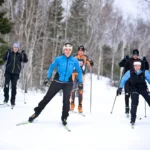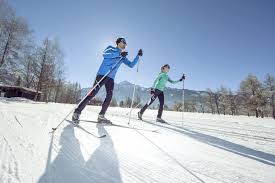
Nordic Walking – An Introduction

Have you ever been out for a walk, felt the invigorating strain of your leg muscles getting exercised, and wished that you could be doing something as healthy and strengthening for your arms? Or else, have your legs been so tired at the end of a long walk or hike that you wish you had some way to take a bit of the strain off of them? Whatever the case may be, Nordic walking with poles is an activity that offers a way to boost the health benefits and overall quality of your walking—whether it’s your daily stroll or an intense weekend hike.
Even if you don’t have any complaints at all about good old fashioned, pole-free walking, you’ll be surprised by how much walking with poles can add to an excursion. Beyond the better workout—Nordic walking engages the entire body—poles can make steep hills and descents more manageable, help you find a natural pace and rhythm, and increase balance and stability on unstable terrain.

So, what exactly is this walking with poles? What does it look like, and how does one start? The goal of Nordic walking is to achieve a more natural walking rhythm, rather than an awkward one. To do this, the poles are medium length (adjustable to the ideal height of just above your navel) and lightweight, making it easy to swing them in an alternating pattern to what your feet are doing. In order to keep your balance on a variety of surfaces, Nordic walking poles come with a variety of tips: rubberized blocky tips for pavement gripping, metal ferrules for rocky or slippery trails, or large compressible tips for shock absorption.
To get started, you simply walk while planting the pole opposite the foot that is striding forward. This is, for most people, just an exaggeration of the way our arms normally swing while we walk. If you’re walking on flat terrain (which is a good starting place to get used to the movement), you don’t need to worry about where the pole tip is going: anywhere you plant it, you will gain some traction. On more challenging surfaces though, hiking on narrow or dicey trails for instance, you may need to plant each pole a bit more deliberately in order to stay balanced. Luckily, this aim-and-plant motion becomes second nature quite quickly.
With just a bit of practice, Nordic walking might become your new favorite workout, or your new way to explore the local backcountry. If you are a Nordic skier in the winter months, Nordic walking with poles can be an exceptional off-season workout: not only does it work and strengthen all the same muscles that skiing relies on, it simulates the movements, rhythms and balance that skiing entails. For an extra dose of winter nostalgia, you can even strap on the poles and go preview ski trails before the snow has fallen, running down those big drops and sweating up the climbs.
For a low cost, low equipment activity, the payoffs of Nordic walking for your health and happiness can be tremendous. So what are you waiting for? Fill out your fall activity schedule with a pair of poles and a whole new approach to walking.
Find LEKI Nordic walking poles from Sunny Sports here!!







































